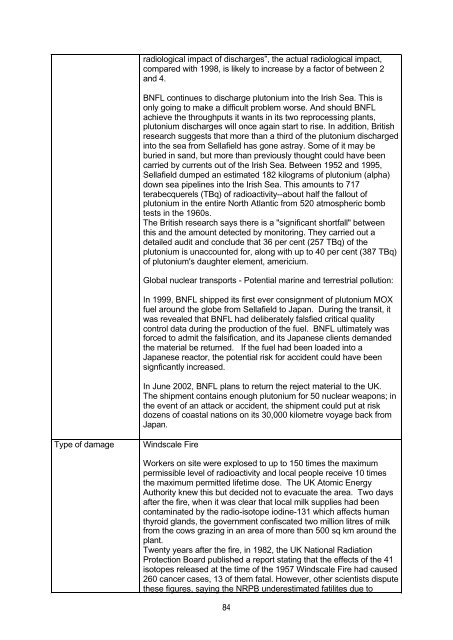Umweltverbrechen multinationaler Konzerne - Greenpeace
Umweltverbrechen multinationaler Konzerne - Greenpeace
Umweltverbrechen multinationaler Konzerne - Greenpeace
Sie wollen auch ein ePaper? Erhöhen Sie die Reichweite Ihrer Titel.
YUMPU macht aus Druck-PDFs automatisch weboptimierte ePaper, die Google liebt.
Type of damage Windscale Fire<br />
radiological impact of discharges”, the actual radiological impact,<br />
compared with 1998, is likely to increase by a factor of between 2<br />
and 4.<br />
BNFL continues to discharge plutonium into the Irish Sea. This is<br />
only going to make a difficult problem worse. And should BNFL<br />
achieve the throughputs it wants in its two reprocessing plants,<br />
plutonium discharges will once again start to rise. In addition, British<br />
research suggests that more than a third of the plutonium discharged<br />
into the sea from Sellafield has gone astray. Some of it may be<br />
buried in sand, but more than previously thought could have been<br />
carried by currents out of the Irish Sea. Between 1952 and 1995,<br />
Sellafield dumped an estimated 182 kilograms of plutonium (alpha)<br />
down sea pipelines into the Irish Sea. This amounts to 717<br />
terabecquerels (TBq) of radioactivity--about half the fallout of<br />
plutonium in the entire North Atlantic from 520 atmospheric bomb<br />
tests in the 1960s.<br />
The British research says there is a "significant shortfall" between<br />
this and the amount detected by monitoring. They carried out a<br />
detailed audit and conclude that 36 per cent (257 TBq) of the<br />
plutonium is unaccounted for, along with up to 40 per cent (387 TBq)<br />
of plutonium's daughter element, americium.<br />
Global nuclear transports - Potential marine and terrestrial pollution:<br />
In 1999, BNFL shipped its first ever consignment of plutonium MOX<br />
fuel around the globe from Sellafield to Japan. During the transit, it<br />
was revealed that BNFL had deliberately falsfied critical quality<br />
control data during the production of the fuel. BNFL ultimately was<br />
forced to admit the falsification, and its Japanese clients demanded<br />
the material be returned. If the fuel had been loaded into a<br />
Japanese reactor, the potential risk for accident could have been<br />
signficantly increased.<br />
In June 2002, BNFL plans to return the reject material to the UK.<br />
The shipment contains enough plutonium for 50 nuclear weapons; in<br />
the event of an attack or accident, the shipment could put at risk<br />
dozens of coastal nations on its 30,000 kilometre voyage back from<br />
Japan.<br />
Workers on site were explosed to up to 150 times the maximum<br />
permissible level of radioactivity and local people receive 10 times<br />
the maximum permitted lifetime dose. The UK Atomic Energy<br />
Authority knew this but decided not to evacuate the area. Two days<br />
after the fire, when it was clear that local milk supplies had been<br />
contaminated by the radio-isotope iodine-131 which affects human<br />
thyroid glands, the government confiscated two million litres of milk<br />
from the cows grazing in an area of more than 500 sq km around the<br />
plant.<br />
Twenty years after the fire, in 1982, the UK National Radiation<br />
Protection Board published a report stating that the effects of the 41<br />
isotopes released at the time of the 1957 Windscale Fire had caused<br />
260 cancer cases, 13 of them fatal. However, other scientists dispute<br />
these figures, saying the NRPB underestimated fatilites due to<br />
84

















